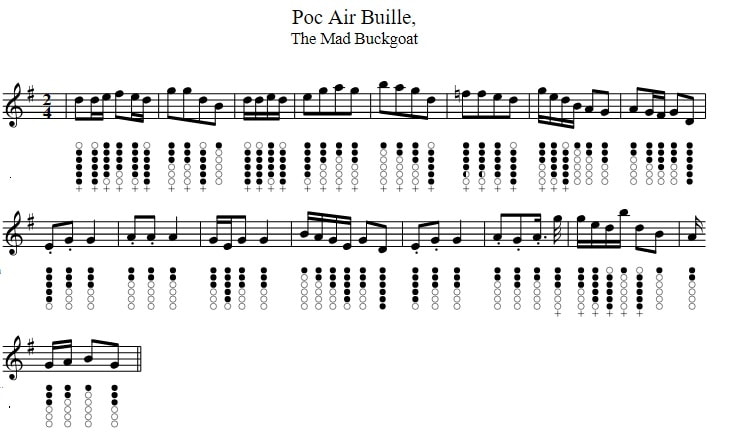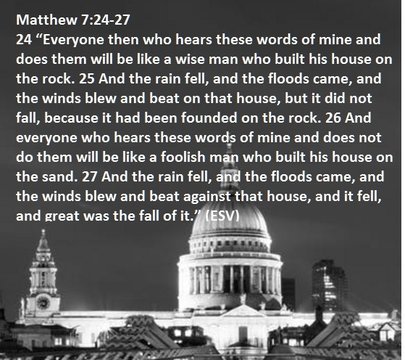An Poc An Buile lyrics and chords
Written by Donal O'Mullain and the singer is Liam Devally 1966 As Gaeilge Lyrics Chords. The sheet music notes for tin whistle are included.
As gaeilge song lyrics
Ar[D] mo ghabáil dom siar[G] chun Droichead Uí[D] Mhórdha,
Píce[D] i m' dhóid is mé ag dul i meitheal,
Cé[G] chasfaí orm i gcumar[D] ceoidh
Ach[A] pocán crón is é ar[D] buile,
[D]Alliliú[G] puilliliu, allil[D]iú tá an poc ar buile.
Do ritheamar trasna trí ruilleogach
Is do ghluais an comhrac ar fud na muinge,
Is treascairt dá bhfuair sé sna turtóga
Chuas ina ainneoin ar a dhroim le fuinneamh
Alliliú puilliliu, alliliú tá an poc ar buile.
Níor fhág sé carraig go raibh scó (scabhat) ann
Ná gur rith le fórsa chun mé a mhilleadh,
Is ea ansin do chaith sé an léim ba mhó
Le fána mhór na Faille Brice,
Alliliú puilliliu, alliliú tá an poc ar buile.
Bhí garda mór i mBaile an Róistigh
Is bhailigh fórsaí chun sinn a chlipeadh,
Do bhuail sé rop dá adhairc sa tóin air
Is dá bhríste nua do dhein sé giobail,
Alliliú puilliliu, alliliú tá an poc ar buile.
I nDaingean Uí Chúis le haghaidh an tráthnóna
Bí an sagart paróiste amach 'nár gcoinnibh,
Is é dúirt gurbh é an diabhal ba dhóigh leis
A ghaibh an treo ar phocán buile!
Alliliú puilliliu, alliliú tá an poc ar buile
Ar[D] mo ghabáil dom siar[G] chun Droichead Uí[D] Mhórdha,
Píce[D] i m' dhóid is mé ag dul i meitheal,
Cé[G] chasfaí orm i gcumar[D] ceoidh
Ach[A] pocán crón is é ar[D] buile,
[D]Alliliú[G] puilliliu, allil[D]iú tá an poc ar buile.
Do ritheamar trasna trí ruilleogach
Is do ghluais an comhrac ar fud na muinge,
Is treascairt dá bhfuair sé sna turtóga
Chuas ina ainneoin ar a dhroim le fuinneamh
Alliliú puilliliu, alliliú tá an poc ar buile.
Níor fhág sé carraig go raibh scó (scabhat) ann
Ná gur rith le fórsa chun mé a mhilleadh,
Is ea ansin do chaith sé an léim ba mhó
Le fána mhór na Faille Brice,
Alliliú puilliliu, alliliú tá an poc ar buile.
Bhí garda mór i mBaile an Róistigh
Is bhailigh fórsaí chun sinn a chlipeadh,
Do bhuail sé rop dá adhairc sa tóin air
Is dá bhríste nua do dhein sé giobail,
Alliliú puilliliu, alliliú tá an poc ar buile.
I nDaingean Uí Chúis le haghaidh an tráthnóna
Bí an sagart paróiste amach 'nár gcoinnibh,
Is é dúirt gurbh é an diabhal ba dhóigh leis
A ghaibh an treo ar phocán buile!
Alliliú puilliliu, alliliú tá an poc ar buile
Introduction
Traditional Irish music has a rich history that is deeply rooted in the culture and identity of the Irish people. It is a form of expression that has been passed down for generations, carrying with it the stories, struggles, and joys of the Irish people. One particular song that has captured the hearts of many and has become a staple in traditional Irish music is the 'An poc ar buile' song. This thesis aims to explore the origins, meaning, and significance of this beloved song in Irish culture and music.
Origins of 'An poc ar buile' Song
The 'An poc ar buile' song is a traditional Irish song that was written by Donal O'Mullain . The title translates to 'The mad goat' in English,
Meaning and Lyrics of 'An poc ar buile' Song
The lyrics of 'An poc ar buile' depict the story of a wild and unruly goat that wreaks havoc in its village. The goat is a metaphor for the rebellious spirit of the Irish people who have a history of resisting British rule and fighting for their independence. The lyrics also portray the goat as a symbol of freedom and rebellion, as it refuses to be tamed or controlled by anyone.
The first verse of the song goes:
'An poc ar buile, a's a' bhata faoi dhó
An poc ar buile, a's a' bhata faoi dhó
An poc ar buile, a's a' bhata faoi dhó
A's níl aon tinteán mar do thinteán féin'
This translates to: 'The mad goat, and his stick on two
The mad goat, and his stick on two
The mad goat, and his stick on two
And there's no hearth like your own hearth'
This verse highlights the rebellious nature of the goat, as it is depicted with its stick on two, symbolizing its strong and independent spirit. The last line also emphasizes the importance of having one's own home and hearth, which is a central aspect of Irish culture and identity.
Significance of 'An poc ar buile' Song
'An poc ar buile' has become a beloved song in Irish music, with its infectious tune and meaningful lyrics resonating with people all over the world. It has been recorded and performed by numerous artists, both in Ireland and abroad, and has become a staple in traditional Irish music sessions.
The song holds great significance in Irish culture, as it represents the rebellious and independent spirit of the Irish people. It is also a reminder of the struggles and hardships that the Irish have faced throughout history, and their determination to overcome them. 'An poc ar buile' has become a symbol of Irish identity and has helped to keep the tradition of Irish music and storytelling alive.
Conclusion
In conclusion, 'An poc ar buile' is a traditional Irish song that has stood the test of time and continues to be a beloved and significant part of Irish culture and music. Its origins, meaning, and lyrics all contribute to its enduring popularity and its ability to capture the hearts of listeners. Through this song, the rebellious and resilient spirit of the Irish people is celebrated and passed down to future generations, ensuring that the legacy of traditional Irish music and culture lives on.
Traditional Irish music has a rich history that is deeply rooted in the culture and identity of the Irish people. It is a form of expression that has been passed down for generations, carrying with it the stories, struggles, and joys of the Irish people. One particular song that has captured the hearts of many and has become a staple in traditional Irish music is the 'An poc ar buile' song. This thesis aims to explore the origins, meaning, and significance of this beloved song in Irish culture and music.
Origins of 'An poc ar buile' Song
The 'An poc ar buile' song is a traditional Irish song that was written by Donal O'Mullain . The title translates to 'The mad goat' in English,
Meaning and Lyrics of 'An poc ar buile' Song
The lyrics of 'An poc ar buile' depict the story of a wild and unruly goat that wreaks havoc in its village. The goat is a metaphor for the rebellious spirit of the Irish people who have a history of resisting British rule and fighting for their independence. The lyrics also portray the goat as a symbol of freedom and rebellion, as it refuses to be tamed or controlled by anyone.
The first verse of the song goes:
'An poc ar buile, a's a' bhata faoi dhó
An poc ar buile, a's a' bhata faoi dhó
An poc ar buile, a's a' bhata faoi dhó
A's níl aon tinteán mar do thinteán féin'
This translates to: 'The mad goat, and his stick on two
The mad goat, and his stick on two
The mad goat, and his stick on two
And there's no hearth like your own hearth'
This verse highlights the rebellious nature of the goat, as it is depicted with its stick on two, symbolizing its strong and independent spirit. The last line also emphasizes the importance of having one's own home and hearth, which is a central aspect of Irish culture and identity.
Significance of 'An poc ar buile' Song
'An poc ar buile' has become a beloved song in Irish music, with its infectious tune and meaningful lyrics resonating with people all over the world. It has been recorded and performed by numerous artists, both in Ireland and abroad, and has become a staple in traditional Irish music sessions.
The song holds great significance in Irish culture, as it represents the rebellious and independent spirit of the Irish people. It is also a reminder of the struggles and hardships that the Irish have faced throughout history, and their determination to overcome them. 'An poc ar buile' has become a symbol of Irish identity and has helped to keep the tradition of Irish music and storytelling alive.
Conclusion
In conclusion, 'An poc ar buile' is a traditional Irish song that has stood the test of time and continues to be a beloved and significant part of Irish culture and music. Its origins, meaning, and lyrics all contribute to its enduring popularity and its ability to capture the hearts of listeners. Through this song, the rebellious and resilient spirit of the Irish people is celebrated and passed down to future generations, ensuring that the legacy of traditional Irish music and culture lives on.



